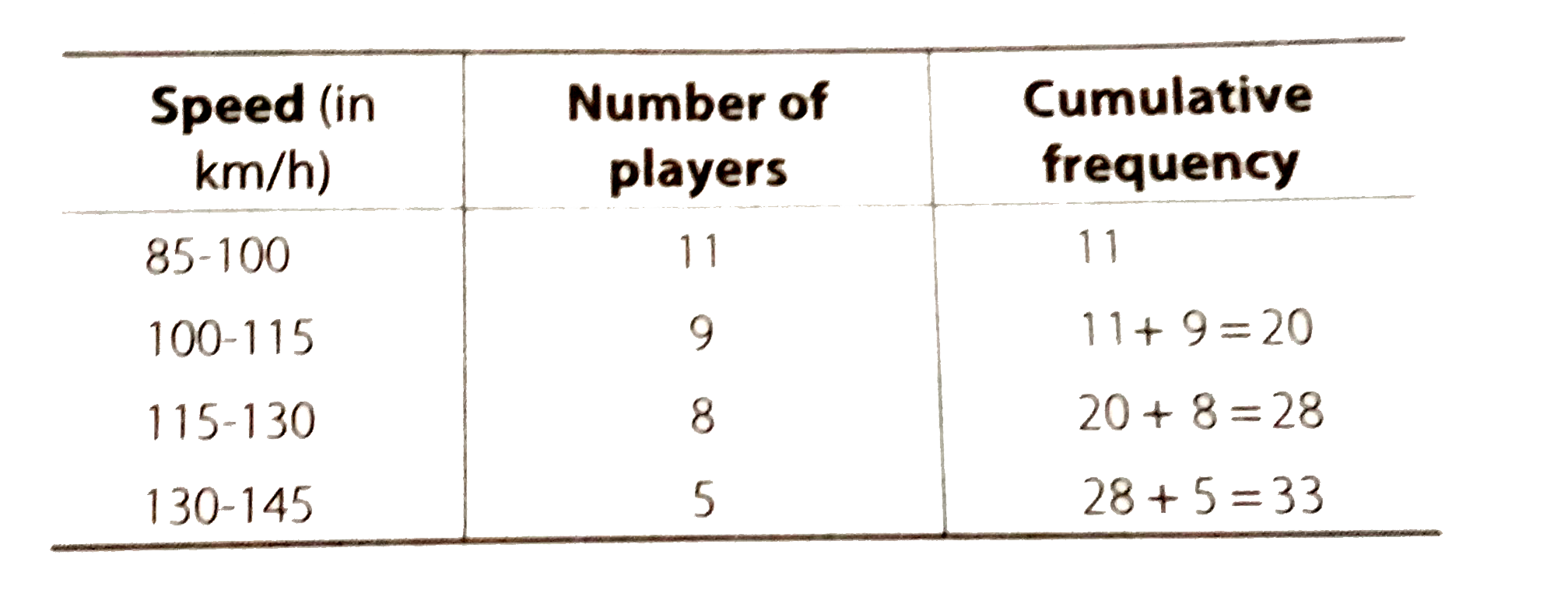The maximum bowling speeds, in km per hour, of 33 players at a cricket coaching centre are given as follows.

Calculate the median bowling speed.
First we construct frequency table

It is given that, n=33
∴n2=332=16.5
So, the median class is 100-115.
Where, lower limit(l)=100,
frequency(f)=9
Cumulative frequency (Cf)=11
Class width (h)=15
Median=l+(n22−cf)f×h
Median=l+(16.5−11)9×15
=100+5.5×159=100+82.59=100+9.17
=109.17
Hence, the median bowling speed is 109.17km//h.
Topper's Solved these Questions
- STATISTICS AND PROBABILITYBOOK - NCERT EXEMPLAR ENGLISHCHAPTER - STATISTICS AND PROBABILITYEXERCISE - LONG ASWERS QUESTIONS
14 Videos
- STATISTICS AND PROBABILITYBOOK - NCERT EXEMPLAR ENGLISHCHAPTER - STATISTICS AND PROBABILITYEXERCISE - VERY SHORT ANSWERS QUESTIONS
14 Videos
- REAL NUMBERSBOOK - NCERT EXEMPLAR ENGLISHCHAPTER - REAL NUMBERSEXERCISE - LONG ANSWER TYPE QUESTIONS
5 Videos
- SURFACE AREAS AND VOLUMESBOOK - NCERT EXEMPLAR ENGLISHCHAPTER - SURFACE AREAS AND VOLUMESEXERCISE - LONG ANSWER TYPE QUESTIONS
20 Videos
Similar Questions
The reduction in speed, r,in miles per hour, of an engine having n bogies attached to it is given as : r=4√n . The final spee d , s, in miles per hour , at which the engine can pull then bogies attached is given as: s=40−r . What is the speed of the train , to the nearest tenths, in miles per hour, when there are 15 bogies attached ?
View SolutionAt a uniform speed of 54 km per hour, a car covers a certain distance in 50 minutes. How mcuh time will it take to cover the same distance at 30 km per hour?
View Solution
Knowledge Check
A stationary source is emitting sound at a fixed frequency f0, which is reflected by two cars approaching the source. The difference between the frequencies of sound reflected from the cars is 1.2% of f0. What is the difference in the speeds of the cars (in km per hour) to the nearest integer ? The cars are moving at constant speeds much smaller than the speed of sound which is 330ms−1.
A2B3C5D7
The reduction is speed, r in miles per hour of an enginge having n bogies attached to it is given as : r=4√n. The final speed, s, in miles per hour , at which the engine can pull the n bogies attached is give as : s=40−r . What is the maximum number of bogies that the engine call pull ?
View SolutionIn a second ODI match between England and India Bhuwnesh kumar bowled his medium fast bowling. He starts his run up from the distance of 50m from the stumps (bowling end) and at the time of bowling a ball,his speed is 36(km)/(hr) and the speed of ball is 144(km)/(hr).
If his mass is 70kg and mass of the ball is 14kg and the heat produce in his body is one tenth of the total work done by him, then
Energy spent by bowler in throwing one ball is :−
View SolutionIn a second ODI match between England and India Bhuwnesh kumar bowled his medium fast bowling. He starts his run up from the distance of 50m from the stumps (bowling end) and at the time of bowling a ball,his speed is 36(km)/(hr) and the speed of ball is 144(km)/(hr).
If his mass is 70kg and mass of the ball is 14kg and the heat produce in his body is one tenth of the total work done by him, then
Select the incorrect statement :
View SolutionA car take 6 hours to reach a distination by travelling at the speed of 50 km per hour. How long will it take when the car travels at the speed of 75 km per hour ?
View SolutionAn automobile driver travels from a plain to a hill station 120 km away at an average speed of 30 km per hour. He then makes the return trip at an average speed 25 km per hour. He covers another 120 km on the plain at an average speed of 50 km per hour. His average speed (in km/hr) over the entire distance of 360 km will be
View SolutionIn a second ODI match between England and India Bhuwnesh kumar bowled his medium fast bowling. He starts his run up from the distance of 50m from the stumps (bowling end) and at the time of bowling a ball,his speed is 36(km)/(hr) and the speed of ball is 144(km)/(hr).
If his mass is 70kg and mass of the ball is 14kg and the heat produce in his body is one tenth of the total work done by him, then
If he accelerates uniformly to the sumps find the average friction force acting on him :−
View SolutionArun is walking at a speed of 6 km per hour. Find the: a. distance Arun will cover in 2 hours. b. time Arun will take to cover 4 km.
View Solution
